The Iowa Certified Automotive Recyclers Environmental (I-CARE) Program and the ARA Certified Auto Recyclers (CAR) program requires that participating yards conduct occupational safety and health employee training as mandated by federal and state OSHA rules as well as training on the safe use of gas cutting torches, if used at the facility. Additionally, some environmental regulations require employee training be conducted annually and documented to maintain compliance.
To meet these safety training needs, Sue Schauls Consulting has introduced the Safety Subscription service. The Safety Subscription is available to any automotive recycler for the subscription price of $179 per year. The Safety Subscription is a monthly safety email (around the 25th of each month) that includes one safety topic and an employee training log. To subscribe send an email to Sue Schauls.
Each month the topic will include timely and pertinent safety information that will meet all I-CARE and CAR certification requirements, environmental regulatory compliance and industry specific safety awareness. The Safety Subscription topic can then be delivered to facility employees either as a presentation at safety meetings or by passing out copies to meet the IOSH and OSHA requirements and when applicable the Iowa DNR permits standards. Following each training session an employee training log should be signed by the trainees and the administrator and maintained in the safety training records such as the facility’s red MSDS binder.
Safety Subscription
MENU
Safety training should not have a beginning and an end, but represent an ongoing effort that continually promotes a safe working environment.
Many standards promulgated by the Occupational Safety and Health Administration (OSHA) explicitly require the employer to train employees in the safety and health aspects of their jobs. Other OSHA standards make it the employer’s responsibility to limit certain job assignments to employees who are “certified,” “competent,” or “qualified”—meaning that they have had special previous training, in or out of the workplace.
These requirements reflect OSHA’s belief that training is an essential part of every employer’s safety and health program for protecting workers from injuries and illnesses. Many researchers conclude that those who are new on the job have a higher rate of accidents and injuries than more experienced workers. OSHA concluded that effective management of worker safety and health protection is a decisive factor in reducing the extent and the severity of work-related injuries and illnesses. Effective management addresses all work-related hazards, whether or not they are regulated by government standards.
The Iowa Occupational Safety and Health Act (IOSHA) applies OSHA standards (29 CFR PARTS 1910 and 1926) as adopted by Iowa Workforce Development, Division of Labor. This agency investigates safety and health complaints in construction and general industry, fatalities/catastrophes and performs general scheduled inspections in Iowa including a review of an employer’s Safety Training documentation and MSDS program. For answers to questions about workplace safety regulation visit the IOSH website at www.iowaworkforce.org/labor/iosh/.
Every automotive recycler should have a Safety Program that includes a designated Saftey Supervisor, a Hazard Communication Plan and a Material Safety Data Sheet (MSDS) program. Having this chemical product information readily available develops a safe work environment. It is the #1 OSHA inspection violation. It is an easy safety compliance requirement to meet.
Preparing and Implementing a Hazard Communication Program
All workplaces where employees are exposed to hazardous chemicals must have a written plan which describes how the standard will be implemented in that facility. The plan does not have to be lengthy or complicated. It is intended to be a blueprint for implementation of your program--an assurance that all aspects of the requirements have been addressed. Download a sample plan.
What is a Material Safety Data Sheet (MSDS)?
A Material Safety Data Sheet (MSDS) is a document that contains information on the potential hazards (health, fire, reactivity and environmental) and how to work safely with a chemical product. It is an essential starting point for the development of a complete health and safety program.
It also contains information on the use, storage, handling and emergency procedures related to the hazards of the material. The MSDS contains much more information about the material than the label. It is intended to tell what the hazards of the product are, how to use the product safely, what to expect if the recommendations are not followed, what to do if accidents occur, how to recognize symptoms of overexposure, and what to do if such incidents occur.
What is a Compliant MSDS Program?
MSDS must be readily accessible to employees when they are in their work areas during their work shifts. Many employers keep the MSDSs in a RED loose-leaf binder in a central location at the facility.
A compliant MSDS program may include:
1. Designate a Safety Supervisor to be responsible for obtaining and maintaining the MSDSs;
2. Develop an Inventory of Products that require an MSDS to be maintained. Download Inventory Form.
3. Establish a RED 3-ring binder of MSDSs gathered or downloaded based on the inventory.
4. Develop procedures to follow when an MSDS is not received at the time of the first shipment;
5. Make sure employees know where to find the MSDS binder.
6. Keep Employee Safety Training logs in the the MSDS binder for easy access inthe event of an inspection.
7. Consider reducing the number of different brands and/or products on hand in the shop to make MSDSs tracking more manageable.
Chemical manufacturers & importers are required to obtain or develop an MSDS for each hazardous chemical they produce. Distributors are responsible for ensuring that their customers are provided a copy of the MSDS. Employers must have an MSDS for each hazardous chemical they use. Employers may rely on the information received from suppliers.




